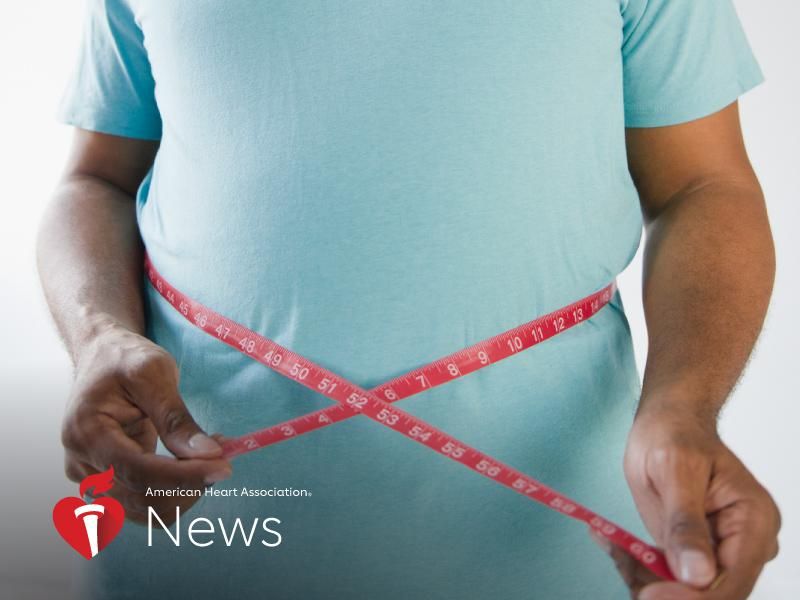WEDNESDAY, Sept. 8, 2021 (American Heart Association News) — Measuring waist circumference may be an essential way to help predict who will develop diabetes among Black people with normal blood sugar levels, according to a new study. The problem is, researchers say, waist size often is overlooked at health visits.
The study, published Wednesday in the Journal of the American Heart Association, focused on how to best determine the risk of diabetes in Black populations. The condition causes blood sugar to rise and can damage the eyes, kidneys, nerves or heart.
About 1 in 10 people in the U.S. have diabetes, but the numbers are higher for Black men (14.7%) and Black women (13.4%), American Heart Association statistics show. According to federal data, Black people are twice as likely as their white counterparts to die of diabetes and three times as likely to end up hospitalized for uncontrolled diabetes.
Researchers looked at nearly 4,000 Black adults without diabetes who had their waist circumference and body mass index measured and received different types of blood and imaging tests to assess body fat. Participants had either normal blood sugar levels or prediabetes, a serious condition when blood sugar levels are higher than normal but not high enough to qualify as diabetes.
After about five years, the study found a simple A1C blood test was the best marker for predicting future diabetes in those who had prediabetes. The test measures average blood sugar levels over the past three months.
However, for participants with normal blood sugar, the researchers found it was better to measure waist circumference as well as liver fat and visceral adipose tissue, a type of fat that surrounds abdominal organs deep inside your body.
Measuring visceral and liver fat can be complicated and costly, but measuring waist circumference is simple and inexpensive, said the study’s lead author Dr. Joshua J. Joseph.
“All you need is a good old-fashioned tape measure,” said Joseph, assistant professor of medicine in the Division of Endocrinology, Diabetes and Metabolism at the Ohio State University Wexner Medical Center in Columbus.
“Waist circumference measurement has fallen off in recent years during office visits. Our (study) is a big reminder about the importance of actually doing that, and considering waist circumference alone, as well in the context of other conditions” such as obesity, he said.
About 55% of Black women and 38% of Black men have obesity, AHA statistics show. Since obesity is a key driver of diabetes, Joseph said it’s important to maintain a healthy weight, eat a nutritious diet and be physically active.
But making and sustaining those changes isn’t easy, Joseph acknowledged. “The bigger question is how do you get these individuals into programming that will actually help them improve their waist circumference and improve their life?”
Possible solutions, Joseph said, are for doctors to prescribe physical activity courses and training for their patients, and encourage them to enroll in nutritious cooking classes and take part in community gardens.
“We also need to address barriers that cut across all racial and ethnic groups. If you don’t have a sidewalk in your community, it’s much tougher to go outside and take a long walk,” he said.
“To make sure everyone can lead longer, healthier lives, we have to work intensively as academic, corporate and government institutions, along with community stakeholders, to really address these social determinants of health.”
Dr. Michelle Kelsey, who was not involved in the research, said the study was limited by its focus on Black adults in Mississippi. “The results may not be generalizable to all African Americans,” she said.
In addition, she said, although everyone in the study had their waist size and BMI measured, not everyone received the same blood and imaging tests.
Still, Kelsey called the study “an important paper that helps us better understand who is likely to develop diabetes. If we can identify people at high risk earlier, we can intervene earlier to improve exercise and dietary habits, so those individuals don’t go on to develop diabetes and all of its complications.”
Kelsey, a cardiology fellow and researcher at Duke University Medical Center in Durham, North Carolina, said while it’s still important to measure a person’s BMI, the study is a reminder that not all body fat is created equal.
“We know that some of the markers of increased visceral (belly) fat are associated with development of diabetes,” she said. “Waist circumference may tell us more about someone’s risk for diabetes in the future than body mass index on its own.”
American Heart Association News covers heart and brain health. Not all views expressed in this story reflect the official position of the American Heart Association. Copyright is owned or held by the American Heart Association, Inc., and all rights are reserved. If you have questions or comments about this story, please email editor@heart.org.
By Thor Christensen
Copyright © 2025 HealthDay. All rights reserved.

